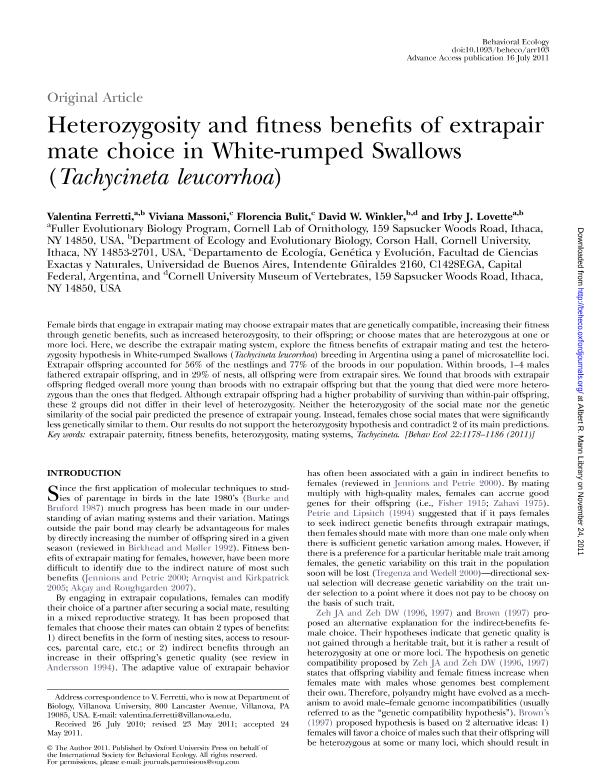Artículo
Heterozygosity and fitness benefits of extrapair mate choice in White-rumped Swallows (Tachycineta leucorrhoa)
Fecha de publicación:
11/2011
Editorial:
Oxford University Press
Revista:
Behavioral Ecology
ISSN:
1045-2249
Idioma:
Inglés
Tipo de recurso:
Artículo publicado
Clasificación temática:
Resumen
Female birds that engage in extrapair mating may choose extrapair mates that are genetically compatible, increasing their fitness through genetic benefits, such as increased heterozygosity, to their offspring; or choose mates that are heterozygous at one or more loci. Here, we describe the extrapair mating system, explore the fitness benefits of extrapair mating and test the heterozygosity hypothesis in White-rumped Swallows (Tachycineta leucorrhoa) breeding in Argentina using a panel of microsatellite loci. Extrapair offspring accounted for 56% of the nestlings and 77% of the broods in our population. Within broods, 1-4 males fathered extrapair offspring, and in 29% of nests, all offspring were from extrapair sires. We found that broods with extrapair offspring fledged overall more young than broods with no extrapair offspring but that the young that died were more heterozygous than the ones that fledged. Although extrapair offspring had a higher probability of surviving than within-pair offspring, these 2 groups did not differ in their level of heterozygosity. Neither the heterozygosity of the social mate nor the genetic similarity of the social pair predicted the presence of extrapair young. Instead, females chose social mates that were significantly less genetically similar to them. Our results do not support the heterozygosity hypothesis and contradict 2 of its main predictions.
Archivos asociados
Licencia
Identificadores
Colecciones
Articulos(IEGEBA)
Articulos de INSTITUTO DE ECOLOGIA, GENETICA Y EVOLUCION DE BS. AS
Articulos de INSTITUTO DE ECOLOGIA, GENETICA Y EVOLUCION DE BS. AS
Citación
Ferretti, Valentina; Massoni, Viviana; Bulit, Florencia; Winkler, David Ward; Lovette, Irby J.; Heterozygosity and fitness benefits of extrapair mate choice in White-rumped Swallows (Tachycineta leucorrhoa); Oxford University Press; Behavioral Ecology; 22; 6; 11-2011; 1178-1186
Compartir
Altmétricas




